Zoom
Trash

Berwick-upon-Tweed. Coordinates: Berwick-upon-Tweed i/ˈbɛrɨk əpɒn ˈtwiːd/ is a town in the county of Northumberland and is the northernmost town in England, on the east coast at the mouth of the River Tweed.
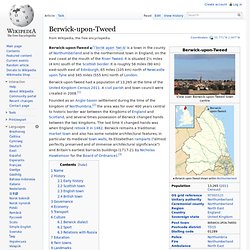
It is situated 2½ miles (4 km) south of the Scottish border. It is roughly 56 miles (90 km) east-south east of Edinburgh, 65 miles (105 km) north of Newcastle upon Tyne and 345 miles (555 km) north of London. Berwick-upon-Tweed had a population of 13,265 at the time of the United Kingdom Census 2011. Name[edit] The name "Berwick" is of Old English origin, and is derived from the term bere-wīc,[4] combining bere, meaning "barley", and wīc, referring to a farm or settlement.
History[edit] Early history[edit] Scottish town[edit] While under Scottish control, Berwick was referred to as "South Berwick" in order to differentiate it from the town of North Berwick, East Lothian, near Edinburgh.[12] Historic sites in Berwick-upon-Tweed. Berwick's town walls are its most famous piece of architecture and still stand strong today, hundreds of years after they were built.
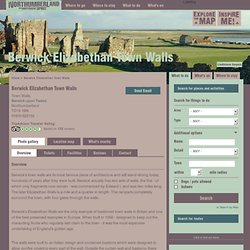
Berwick actually has two sets of walls, the first - of which only fragments now remain - was commenced by Edward I, and was two miles long. The later Elizabethan Walls is a mile and a-quarter in length. The ramparts completely surround the town, with four gates through the walls. Capture of Berwick (1482) Coordinates: Berwick upon Tweed and its castle were captured by the English in 1482 during the Anglo-Scottish Wars.
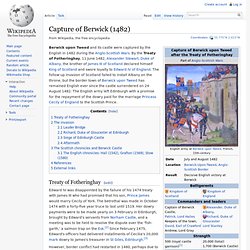
By the Treaty of Fotheringhay, 11 June 1482, Alexander Stewart, Duke of Albany, the brother of James III of Scotland declared himself King of Scotland and swore loyalty to Edward IV of England. Berwick-upon-Tweed Feature Page on Undiscovered Scotland. England or Scotland?
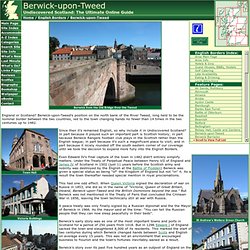
Berwick-upon-Tweed's position on the north bank of the River Tweed, long held to be the nominal border between the two countries, led to the town changing hands no fewer than 14 times in the two centuries up to 1482. Since then it's remained English, so why include it in Undiscovered Scotland? In part because it played such an important part is Scottish history; in part because Berwick Rangers football club plays in the Scottish rather than the English league; in part because it's such a magnificent place to visit; and in part because it nicely rounded off the south eastern corner of our coverage until we took the decision to expand more fully into the English Borders.
Even Edward IV's final capture of the town in 1482 didn't entirely simplify matters. This had one odd effect. A peace treaty was only finally signed by a Russian diplomat and the the Mayor of Berwick in 1966. Read about Thomas D. Berwick upon Tweed - A Visitors Guide. Berwick-upon-Tweed tourist information. Arguably England’s most dramatic walled town, at the most northerly tip of Northumberland, Berwick-upon-Tweed, as seen on ITV's Tales from Northumberland crowns the county.
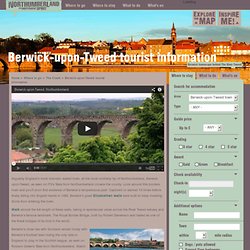
Look around this borders town and you’ll soon find evidence of Berwick’s tempestuous past. Captured or sacked 13 times before finally falling into English hands in 1482, Berwick’s great Elizabethan walls were built to keep invading Scots from entering the town. Walk almost the full length of these walls, taking in spectacular views across the River Tweed estuary and Berwick’s famous landmark, The Royal Border Bridge, built by Robert Stevenson and hailed as one of the finest bridges of its kind in the world. A view across Berwick-upon-Tweed Estuary Berwick’s close ties with Scotland remain today with Berwick’s football team being the only side in England to play in the Scottish league, as seen on Robson Green's Tales from Northumberland. Berwick upon Tweed, links to Berwick, Berwick Borough, Lindisfarne, Holy Island.
The Official Visitor Website for Berwick-upon-Tweed. Berwick-upon-Tweed Castle and Ramparts. Berwick-upon-Tweed - Northumberland. Berwick-upon-Tweed travel tips: climb the Tudor walls for jaw-dropping views. Berwick-upon-Tweed is the last town in England in the least populated county, so it should feel remote and parochial.
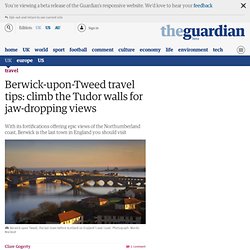
It certainly feels undiscovered; its handsome Georgian sandstone houses, slate and red-tiled rooftops, and complete set of 16th-century fortifications (the walled town sits on the much disputed border between England and Scotland), including a bridge over the river Tweed, rarely fail to drop the jaws of those visiting for the first time. Parochial, however, it is not.
An hour by car from Edinburgh, it has some of that city's strength of character. Shops selling local produce and resident artist Mark Irving's gallery (the-irving-gallery.co.uk) on Bridge Street have brought a bohemian vibe to the town, which now depends on tourism for its livelihood rather than the salmon and wool trade of old. No 1 Sallyport's central location means it is easy to venture outside and climb on to the medieval walls. Introduction to Berwick-upon-Tweed Town Council. Berwick-upon-Tweed Town Council was created on 3rd March 2008 and has 16 voluntary Councillors who represent 7 wards covering Berwick, Tweedmouth and Spittal, which have a combined population of about 11,500.
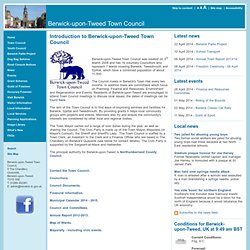
The Council meets in Berwick's Town Hall every two months. In addition there are committees which focus on Planning, Finance and Resources, Environment and Regeneration and Events. Residents of Berwick-upon-Tweed are encouraged to attend Town Council meetings to discuss local issues; the dates of meetings can be found here. The aim of the Town Council is to find ways of improving services and facilities for Berwick, Spittal and Tweedmouth. By providing grants it helps local community groups with projects and events. The Town Mayor carries out a range of civic duties during the year, as well as chairing the Council.
Explore Berwick. Berwick upon Tweed - Discovering Britain. Music, Arts and Creative Centre in Berwick Upon Tweed. Berwick-upon-Tweed Photos - Featured Images of Berwick-upon-Tweed, Northumberland. Things to do in Berwick-upon-Tweed – 9 Berwick-upon-Tweed Attractions. Berwick Castle. Coordinates: Berwick Castle is a ruined castle in Berwick-upon-Tweed, Northumberland, England.

The castle was founded in the 12th century by the Scottish King David I. In 1296-8, the English King Edward I had the castle rebuilt and the town fortified, before it was returned to Scotland. In 1330 "Domino Roberto de Lawedre" of The Bass, described as Custodian or Keeper of the Marches and the Castle of Berwick-upon-Tweed, received, apparently upon the termination of his employment there, £33.6s.8d, plus a similar amount, from the Scottish Exchequer.[1] The town and castle changed hands several times during the English-Scottish conflicts. In 1464 the Exchequer Rolls of Scotland record that Robert Lauder of Edrington was paid £20 for repairs made to Berwick Castle. The castle's location in the hotly disputed border country between England and Scotland made it one of the most important strongholds in the British Isles, and it enjoyed an eventful history.
References[edit] External links[edit]